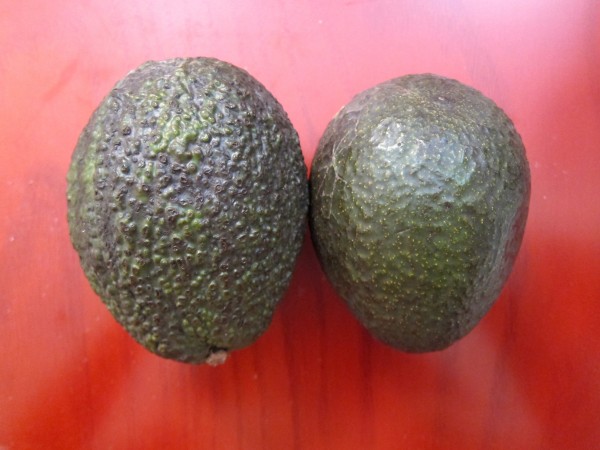
On the left is a Hass avocado from Peru, on the right is a Hass avocado from California.
Hass avocado is a cultivar of avocado, and it has a cute history. In 1925, Mr. Rudolph Hass, an amateur horticulturist, bought a small 1.5 acre avocado grove in La Habra Heights, Southern California. His plan was to graft old Fuerte avocado branches – at the time, Fuerte was the best avocado cultivar – with young saplings grown from some avocado seeds, which were sold at a local nursery. Those seeds were cross-pollinated many times by nature, and the grafting did not go well for one of the young trees [little stubborn sapling!], but per his grafter’s advice, Mr. Hass kept that sapling to see what would happen anyway. When the sapling was only over a foot tall (some time in 1926), it bore three fruits [d’awww!].
Normally, the Fuerte cultivar would take at least five years to produce fruits. Not only the odd stubborn young tree grew faster than the Fuerte, it also grew straight up and did not spread as wide, so it was more land-efficient (more trees per acre). Most importantly, its fruits tasted the same, if not better than the Fuerte. Hence, the Hass avocado became the most popular varietal, making up 95% of all today commercially grown avocados. [Moral of the story: don’t cut down your tree even if it refuses to do what you want at first. 🙂 ]
Back to California vs. Peru.
Both of these are Hass avocados, and they’re roughly the same size (the Peruvian ones are slightly bigger). At Berkeley Bowl, the Peruvian Hass avocados were sold for 89 cents each. This is insanely cheap, considering the Californian ones (labelled “XX Large Hass avocado”) go for 1.69 dollars each. [How can imported produce be so cheap? I feel bad for the Peruvian farmers!] While I’m loyal to the Cali ones, I also love cheap things to try new things. I bought four of each type.
Appearance: Cali: smooth skin, Peru: bumpy skin.
(Now I understand why avocados are also called “alligator pear” – although I’ve never heard anyone say that myself).
Convenience: Cali: knife easily cuts through the skin, Peru: I basically had to saw it open [same knife, in case you wonder]. So yes, the Peruvian skin is much thicker.
Taste: Cali: normal buttery, Peru: quite bland.
More concrete comparison: I always mash avocado, add some sugar and chill it in the fridge –> instant dessert (like ice cream). For the Cali avocado, 1 teaspoon of sugar is enough. For the Peru one, I add 2 teaspoons of sugar and it’s still bland (like a potato).
Texture: Cali: soft, Peru: hardy and stringy.
I couldn’t even mash the Peru one. Not because it’s not ripe. It was actually so ripe that the meat already darkened, but it was somewhat unyielding like a waxy potato. I also had to pull strings out of my “ice cream”, this avocado was so old a tree would grow out of it the next day.
I’m not going to preach locavorism or anything, but it’s clear which one is the better choice. (Supermarket fruits are always picked unripe to survive the transportation, so I have doubts that the Peruvian avocados are actually inferior to the Californian ones, it’s just that they were transported from much further away, it’s a wonder they managed to preserve any flavor at all.)
Leave a Reply